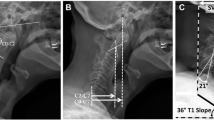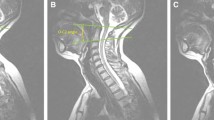Abstract
Purpose
Patients with cervical spondylosis commonly present with neck pain, radiculopathy or myelopathy. As degenerative changes progress, multiple factors including disc height loss, thoracic kyphosis, and facetogenic changes can increase the risk of neural structure compression. This study investigated the impact of cervical deformity including forward head posture (FHP) and upper thoracic kyphosis, on the anatomy of the cervical neural foramen.
Methods
Postural changes of 13 human cervical spine specimens (Occiput-T1, age 50.6 years; range 21–67) were assessed in response to prescribed cervical sagittal malalignments using a previously reported experimental model. Two characteristics of cervical sagittal deformities, C2–C7 sagittal vertical alignment (SVA) and sagittal angle of the T1 vertebra (T1 tilt), were varied to create various cervical malalignments. The postural changes were documented by measuring vertebral positions and orientations. The vertebral motion data were combined with specimen-specific CT-based anatomical models, which allowed assessments of foraminal areas of subaxial cervical segments as a function of increasing C2–C7 SVA and changing T1 tilt.
Results
Increasing C2–C7 SVA from neutral posture resulted in increased neural foraminal area in the lower cervical spine (largest increase at C4–C5: 13.8 ± 15.7 %, P < 0.01). Increasing SVA from a hyperkyphotic posture (greater T1 tilt) also increased the neural foraminal area in the lower cervical segments (C5–C6 demonstrated the largest increase: 13.4 ± 9.6 %, P < 0.01). The area of the cervical neural foramen decreased with increasing T1 tilt, with greater reduction occurring in the lower cervical spine, specifically at C5–C6 (−8.6 ± 7.0 %, P < 0.01) and C6–C7 (−9.6 ± 5.6 %, P < 0.01).
Conclusion
An increase in thoracic kyphosis (T1 tilt) decreased cervical neural foraminal areas. In contrast, an increase in cervical SVA increased the lower cervical neural foraminal areas. Patients with increased upper thoracic kyphosis may respond with increased cervical SVA as a compensatory mechanism to increase their lower cervical neural foraminal area.











Similar content being viewed by others
Abbreviations
- CT:
-
Computed tomography
- FHP:
-
Forward head posture
- SVA:
-
Sagittal vertical alignment
- 3D:
-
Three-dimensional
- MR:
-
Magnetic resonance
References
Ferrara LA (2012) The biomechanics of cervical spondylosis. Adv Orthop 2012:493605. doi:10.1155/2012/493605
Humphreys SC, Hodges SD, Patwardhan A, Eck JC, Covington LA, Sartori M (1998) The natural history of the cervical foramen in symptomatic and asymptomatic individuals aged 20–60 years as measured by magnetic resonance imaging. A descriptive approach. Spine 23:2180–2184
Tang JA, Scheer JK, Smith JS, Deviren V, Bess S, Hart RA, Lafage V, Shaffrey CI, Schwab F, Ames CP, ISSG (2012) The impact of standing regional cervical sagittal alignment on outcomes in posterior cervical fusion surgery. Neurosurgery 71:662–669. doi:10.1227/NEU.0b013e31826100c9 (discussion 669)
Hardacker JW, Shuford RF, Capicotto PN, Pryor PW (1997) Radiographic standing cervical segmental alignment in adult volunteers without neck symptoms. Spine 22:1472–1480 (discussion 1480)
Knott PT, Mardjetko SM, Techy F (2010) The use of the T1 sagittal angle in predicting overall sagittal balance of the spine. Spine J Off J N Am Spine Soc 10:994–998. doi:10.1016/j.spinee.2010.08.031
Patwardhan AG, Havey RM, Khayatzadeh S, Muriuki MG, Voronov LI, Carandang G, Nguyen NL, Ghanayem AJ, Schuit D, Patel AA, Smith ZA, Sears W (2015) Postural consequences of cervical sagittal imbalance—a novel laboratory model. Spine. doi:10.1097/BRS.0000000000000877
Radhakrishnan K, Litchy WJ, O’Fallon WM, Kurland LT (1994) Epidemiology of cervical radiculopathy. A population-based study from Rochester, Minnesota, 1976 through 1990. Brain J Neurol 117(Pt 2):325–335
Miyazaki M, Hong SW, Yoon SH, Zou J, Tow B, Alanay A, Abitbol JJ, Wang JC (2008) Kinematic analysis of the relationship between the grade of disc degeneration and motion unit of the cervical spine. Spine 33:187–193. doi:10.1097/BRS.0b013e3181604501
Yoganandan N, Pintar FA, Zhang J, Baisden JL (2009) Physical properties of the human head: mass, center of gravity and moment of inertia. J Biomech 42:1177–1192. doi:10.1016/j.jbiomech.2009.03.029
Madsen DP, Sampson WJ, Townsend GC (2008) Craniofacial reference plane variation and natural head position. Eur J Orthod 30:532–540. doi:10.1093/ejo/cjn031
Been E, Shefi S, Zilka LR, Soudack M (2014) Foramen magnum orientation and its association with cervical lordosis: a model for reconstructing cervical curvature in archeological and extinct Hominin specimens. Adv Anthropol 2014
Nojiri K, Matsumoto M, Chiba K, Maruiwa H, Nakamura M, Nishizawa T, Toyama Y (2003) Relationship between alignment of upper and lower cervical spine in asymptomatic individuals. J Neurosurg 99:80–83
Gore DR, Sepic SB, Gardner GM (1986) Roentgenographic findings of the cervical spine in asymptomatic people. Spine 11:521–524
Martin S, Ghanayem A, Tzermiadianos M et al (2011) Kinematics of cervical total disc replacement adjacent to a two-level, straight vs. lordotic fusion. Spine (Phila Pa 1976) 36(17):1359–1366
Lee M, Dumonski M, Phillips F et al (2011) Disc replacement adjacent to cervical fusion: a biomechanical comparison of hybrid construct vs. two-level fusion. Spine (Phila Pa 1976) 36(23):1932–1939
Havey RM, Goodsitt J, Khayatzadeh S, Muriuki M, Potluri T, Voronov LI, Lomasney LM, Patwardhan AG (2015) Three-dimensional computed tomography based specimen-specific kinematic model for ex vivo assessment of lumbar neuroforaminal space. Spine (Phila Pa 1976) 40(14):E814–E822. doi: 10.1097/BRS.0000000000000959
Park JH, Cho CB, Song JH, Kim SW, Ha Y, Oh JK (2013) T1 slope and cervical sagittal alignment on cervical CT radiographs of asymptomatic persons. J Korean Neurosurg Soc 53:356–359. doi:10.3340/jkns.2013.53.6.356
Jenis LG, Banco S, Jacquemin JJ, Lin KH (2004) The effect of posterior cervical distraction on foraminal dimensions utilizing a screw-rod system. Spine 29:763–766
Pingel A, Kandziora F (2013) Anterior decompression and fusion for cervical neuroforaminal stenosis. Eur Spine J Off Publ Eur Spine Soc Eur Spinal Deform Soc Eur Sect Cerv Spine Res Soc 22:671–672. doi:10.1007/s00586-013-2709-5
Hojo Y, Ito M, Abumi K, Kotani Y, Sudo H, Takahata M, Minami A (2011) A late neurological complication following posterior correction surgery of severe cervical kyphosis. Eur Spine J Off Publ Eur Spine Soc Eur Spinal Deform Soc Eur Sect Cerv Spine Res Soc 20:890–898. doi:10.1007/s00586-010-1590-8
Nicotra A, Khalil NM, O’Neill K (2011) Cervical radiculopathy: discrepancy or concordance between electromyography and magnetic resonance imaging? Br J Neurosurg 25:789–790. doi:10.3109/02688697.2011.594189
Guzman JZ, Baird EO, Fields AC, McAnany SJ, Qureshi SA, Hecht AC, Cho SK (2014) C5 nerve root palsy following decompression of the cervical spine: a systematic evaluation of the literature. Bone Joint J 96-B:950–955. doi:10.1302/0301-620X.96B7.33665
Panjabi MM, Maak TG, Ivancic PC, Ito S (2006) Dynamic intervertebral foramen narrowing during simulated rear impact. Spine 31:E128–E134. doi:10.1097/01.brs.0000201243.81745.ba
Yoo JU, Zou D, Edwards WT, Bayley J, Yuan HA (1992) Effect of cervical spine motion on the neuroforaminal dimensions of human cervical spine. Spine 17:1131–1136
Nuckley DJ, Konodi MA, Raynak GC, Ching RP, Mirza SK (2002) Neural space integrity of the lower cervical spine: effect of normal range of motion. Spine 27:587–595
Humphreys SC, Chase J, Patwardhan A, Shuster J, Lomasney L, Hodges SD (1998) Flexion and traction effect on C5–C6 foraminal space. Arch Phys Med Rehabil 79:1105–1109
Kitagawa T, Fujiwara A, Kobayashi N, Saiki K, Tamai K, Saotome K (2004) Morphologic changes in the cervical neural foramen due to flexion and extension: in vivo imaging study. Spine 29:2821–2825
Muhle C, Resnick D, Ahn JM, Sudmeyer M, Heller M (2001) In vivo changes in the neuroforaminal size at flexion-extension and axial rotation of the cervical spine in healthy persons examined using kinematic magnetic resonance imaging. Spine 26:E287–E293
Anderst WJ (2012) Automated measurement of neural foramen cross-sectional area during in vivo functional movement. Comput Methods Biomech Biomed Eng 15:1313–1321. doi:10.1080/10255842.2011.590450
Acknowledgments
Investigation performed at the Musculoskeletal Biomechanics Laboratory, Edward Hines Jr. VA Hospital, Hines, Illinois, USA. Funding provided by the Rehabilitation Research and Development Service, Department of Veterans Affairs (Grant 1-I01-RX-001269-01-A2), and Northwestern Feinberg School of Medicine, Department of Neurosurgery, Chicago, Illinois, USA.
Author information
Authors and Affiliations
Corresponding author
Ethics declarations
Conflict of interest
Z. A. S: Funded by Spine Society of Europe Developmental Grant (Paid directly to institution); S. K: Nothing to disclose; J. B: Nothing to disclose; M. H: Nothing to disclose; R. M. H: Nothing to disclose; L. I. V: Nothing to disclose; M. G. M: Nothing to disclose; A. G. P: Funded by US Department of Veterans Affairs (Grant 1-I01-RX-001269-01-A2).
Rights and permissions
About this article
Cite this article
Smith, Z.A., Khayatzadeh, S., Bakhsheshian, J. et al. Dimensions of the cervical neural foramen in conditions of spinal deformity: an ex vivo biomechanical investigation using specimen-specific CT imaging. Eur Spine J 25, 2155–2165 (2016). https://doi.org/10.1007/s00586-016-4409-4
Received:
Revised:
Accepted:
Published:
Issue Date:
DOI: https://doi.org/10.1007/s00586-016-4409-4




